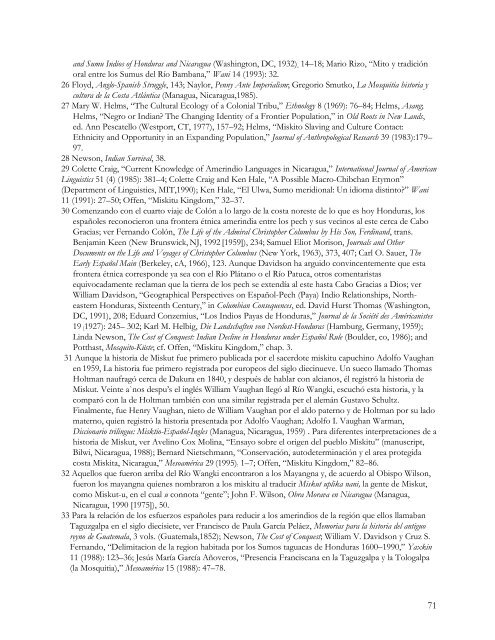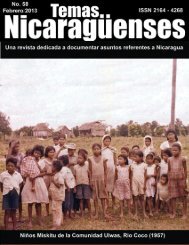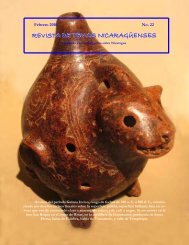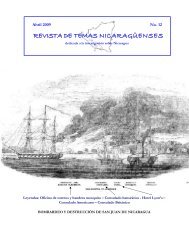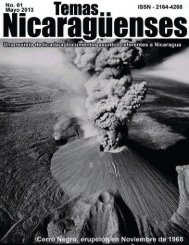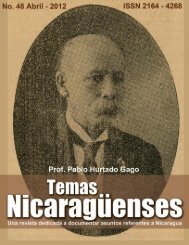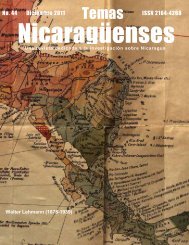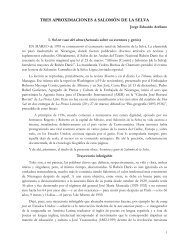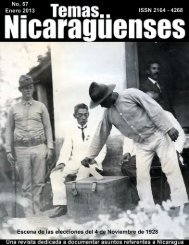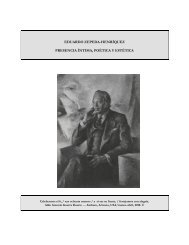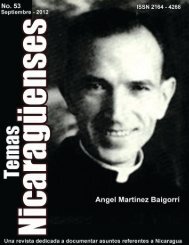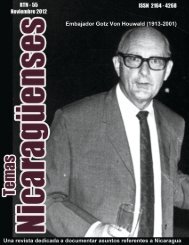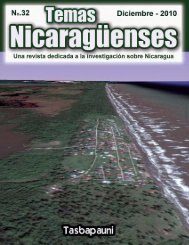21 - Revista de Temas Nicaragüenses
21 - Revista de Temas Nicaragüenses
21 - Revista de Temas Nicaragüenses
You also want an ePaper? Increase the reach of your titles
YUMPU automatically turns print PDFs into web optimized ePapers that Google loves.
and Sumu Indios of Honduras and Nicaragua (Washington, DC, 1932), 14–18; Mario Rizo, “Mito y tradición<br />
oral entre los Sumus <strong>de</strong>l Río Bambana,” Wani 14 (1993): 32.<br />
26 Floyd, Anglo-Spanish Struggle, 143; Naylor, Penny Ante Imperialism; Gregorio Smutko, La Mosquitia historia y<br />
cultura <strong>de</strong> la Costa Atlántica (Managua, Nicaragua,1985).<br />
27 Mary W. Helms, “The Cultural Ecology of a Colonial Tribu,” Ethnology 8 (1969): 76–84; Helms, Asang;<br />
Helms, “Negro or Indian? The Changing I<strong>de</strong>ntity of a Frontier Population,” in Old Roots in New Lands,<br />
ed. Ann Pescatello (Westport, CT, 1977), 157–92; Helms, “Miskito Slaving and Culture Contact:<br />
Ethnicity and Opportunity in an Expanding Population,” Journal of Anthropological Research 39 (1983):179–<br />
97.<br />
28 Newson, Indian Survival, 38.<br />
29 Colette Craig, “Current Knowledge of Amerindio Languages in Nicaragua,” International Journal of American<br />
Linguistics 51 (4) (1985): 381–4; Colette Craig and Ken Hale, “A Possible Macro-Chibchan Etymon”<br />
(Department of Linguistics, MIT,1990); Ken Hale, “El Ulwa, Sumo meridional: Un idioma distinto?” Wani<br />
11 (1991): 27–50; Offen, “Miskitu Kingdom,” 32–37.<br />
30 Comenzando con el cuarto viaje <strong>de</strong> Colón a lo largo <strong>de</strong> la costa noreste <strong>de</strong> lo que es hoy Honduras, los<br />
españoles reconocieron una frontera étnica amerindia entre los pech y sus vecinos al este cerca <strong>de</strong> Cabo<br />
Gracias; ver Fernando Colón, The Life of the Admiral Christopher Columbus by His Son, Ferdinand, trans.<br />
Benjamin Keen (New Brunswick, NJ, 1992 [1959]), 234; Samuel Eliot Morison, Journals and Other<br />
Documents on the Life and Voyages of Christopher Columbus (New York, 1963), 373, 407; Carl O. Sauer, The<br />
Early Español Main (Berkeley, cA, 1966), 123. Aunque Davidson ha arguido convincentemente que esta<br />
frontera étnica correspon<strong>de</strong> ya sea con el Río Plátano o el Río Patuca, otros comentaristas<br />
equivocadamente reclaman que la tierra <strong>de</strong> los pech se extendía al este hasta Cabo Gracias a Dios; ver<br />
William Davidson, “Geographical Perspectives on Español-Pech (Paya) Indio Relationships, Northeastern<br />
Honduras, Sixteenth Century,” in Columbian Consequences, ed. David Hurst Thomas (Washington,<br />
DC, 1991), 208; Eduard Conzemius, “Los Indios Payas <strong>de</strong> Honduras,” Journal <strong>de</strong> la Société <strong>de</strong>s Américanistes<br />
19 (1927): 245– 302; Karl M. Helbig, Die Landschaften von Nordost-Honduras (Hamburg, Germany, 1959);<br />
Linda Newson, The Cost of Conquest: Indian Decline in Honduras un<strong>de</strong>r Español Rule (Boul<strong>de</strong>r, co, 1986); and<br />
Potthast, Mosquito-Küste; cf. Offen, “Miskitu Kingdom,” chap. 3.<br />
31 Aunque la historia <strong>de</strong> Miskut fue primero publicada por el sacerdote miskitu capuchino Adolfo Vaughan<br />
en 1959, La historia fue primero registrada por europeos <strong>de</strong>l siglo diecinueve. Un sueco llamado Thomas<br />
Holtman naufragó cerca <strong>de</strong> Dakura en 1840, y <strong>de</strong>spués <strong>de</strong> hablar con alcianos, él registró la historia <strong>de</strong><br />
Miskut. Veinte a`nos <strong>de</strong>spu’s el inglés William Vaughan llegó al Río Wangki, escuchó esta historia, y la<br />
comparó con la <strong>de</strong> Holtman también con una similar registrada per el alemán Gustavo Schultz.<br />
Finalmente, fue Henry Vaughan, nieto <strong>de</strong> William Vaughan por el aldo paterno y <strong>de</strong> Holtman por su lado<br />
materno, quien registró la historia presentada por Adolfo Vaughan; Adolfo I. Vaughan Warman,<br />
Diccionario trilingue: Misktio-Español-Ingles (Managua, Nicaragua, 1959) . Para diferentes interpretaciones <strong>de</strong> a<br />
historia <strong>de</strong> Miskut, ver Avelino Cox Molina, “Ensayo sobre el origen <strong>de</strong>l pueblo Miskitu” (manuscript,<br />
Bilwi, Nicaragua, 1988); Bernard Nietschmann, “Conservación, auto<strong>de</strong>terminación y el area protegida<br />
costa Miskita, Nicaragua,” Mesoamérica 29 (1995): 1–7; Offen, “Miskitu Kingdom,” 82–86.<br />
32 Aquellos que fueron arriba <strong>de</strong>l Río Wangki encontraron a los Mayangna y, <strong>de</strong> acuerdo al Obispo Wilson,<br />
fueron los mayangna quienes nombraron a los miskitu al traducir Miskut uplika nani, la gente <strong>de</strong> Miskut,<br />
como Miskut-u, en el cual u connota “gente”; John F. Wilson, Obra Morava en Nicaragua (Managua,<br />
Nicaragua, 1990 [1975]), 50.<br />
33 Para la relación <strong>de</strong> los esfuerzos españoles para reducir a los amerindios <strong>de</strong> la región que ellos llamaban<br />
Taguzgalpa en el siglo diecisiete, ver Francisco <strong>de</strong> Paula García Peláez, Memorias para la historia <strong>de</strong>l antiguo<br />
reyno <strong>de</strong> Guatemala, 3 vols. (Guatemala,1852); Newson, The Cost of Conquest; William V. Davidson y Cruz S.<br />
Fernando, “Delimitacion <strong>de</strong> la region habitada por los Sumos taguacas <strong>de</strong> Honduras 1600–1990,” Yaxkin<br />
11 (1988): 123–36; Jesús María García Añoveros, “Presencia Franciscana en la Taguzgalpa y la Tologalpa<br />
(la Mosquitia),” Mesoamérica 15 (1988): 47–78.<br />
71


